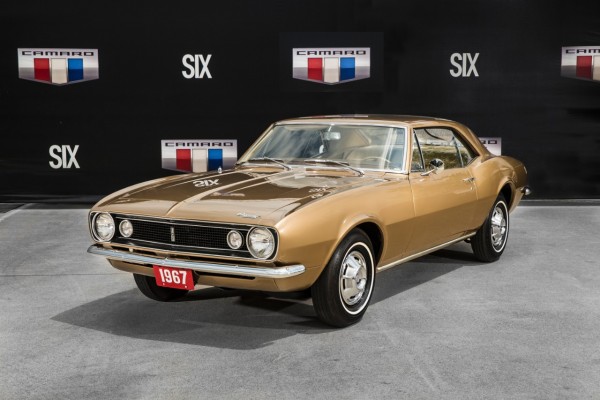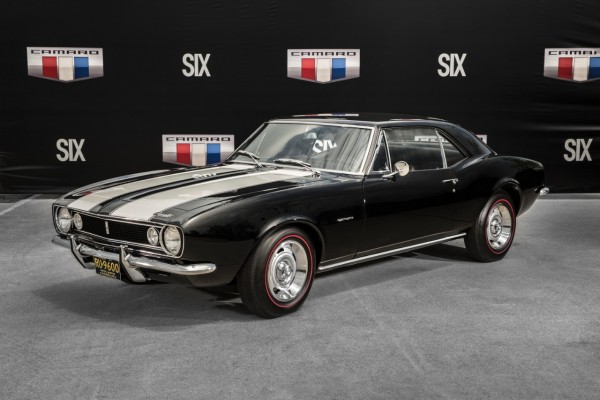1967 Camaro – VIN #100001: This 1967 Camaro is documented as the first of 49 hand-built “pilot assembly” vehicles built at the Norwood, Ohio plant in mid-1966 – early models built for evaluation before regular production commenced. It was fitted with a 3.7L inline-six engine and a three-speed manual transmission.
1967 Camaro Z/28: Developed specifically to homologate the new Camaro for SCCA’s popular Trans-Am road-racing series, the Z/28 package was developed with special chassis and suspension components, along with a unique 302-cubic-inch version of the small block V-8 engine required to accommodate class rules limiting engine displacement to 305 cubic inches. Only 602 examples were built in 1967.
1967 Camaro “Grumpy’s Toy”: This is the legendary Bill “Grumpy” Jenkins 396-powered Camaro that tore through NHRA’s Super Stock class for the 1967 championship – and set the stage for his influential involvement in Pro Stock, which debuted in 1970. It is believed this car may have been the first Camaro built with the L78-code 396 engine, rated at 375 hp. Regardless, it’s a piece of drag racing history.
1968 Camaro Z/28 convertible: A one-of-none special model – the Z/28 wasn’t offered as a convertible – built for Chevrolet general manager Pete Estes, this hand-built specialty Camaro not only fulfilled his desire for performance-oriented convertible with a full complement of features, but helped convince him to keep the Z/28 in the lineup for 1969.
1969 Camaro ZL1: This Cortez Silver Camaro ZL1 is number 66 of the 69 built in 1969 – all built through the COPO special order system with an all-aluminum 427 big-block engine. The first 50 were ordered by Illinois Chevy dealer Fred Gibb, because that was the minimum number of production vehicles NHRA required for Super Stock class eligibility.
1969 Yenko Camaro: Another COPO special order-based performance model – with an iron-block 427 engine – this is one of around 200 created by Pennsylvania Chevrolet dealer Don Yenko. It is in very original condition, with a single re-spray of its Hugger Orange exterior color on all-original sheet metal. The drivetrain is believed to have never been removed and of the approximately 200 Yenko Camaros built, it is one of only 30 to be equipped with a Turbo 400 three-speed automatic transmission.
1967/1968 Camaro Z/28 Penske/Sunoco race car: In 1967, Roger Penske was beginning his long and remarkable career as a businessman and racing team owner. He quickly teamed with driver Mark Donohue and began a dual assault on two SCCA Professional Series: the US Road Racing Championship and the Trans-Am using Chevy powered Lola race cars and the all-new Chevy Camaro.
1970 Camaro Z28 ‘Hurst Sunshine Special’: It was the first year of the Camaro’s second generation and was also the high water mark for its performance, with the 360-hp LT-1 engine. It featured a solid-lifter camshaft and a high, 11.0:1 compression ratio. This unique version is the Hurst Sunshine Special, one of three cars built with a prototype power-sliding sunroof – a feature that never saw production.
1974 Camaro Z28: Representing the first year of a new, sloping front-end design and wraparound taillamps, the 1974 Camaro’s facelift answered new federal bumper standards. New extruded and polished aluminum front and rear bumper added nearly 7 inches to the car’s overall length. The Camaro Z28 featured a 245-hp version of the 5.7L small block V-8 engine, along with front and rear spoilers and a bold hood graphic that left no ambiguity to the car’s designation.
A rare Canadian model, which features a 170-hp 5.7L small block V-8 and a three-speed automatic transmission, this 1978 Z28 featured an updated appearance with body-color, urethane front and rear bumpers.
1981 Camaro Pro Stock race car: This historic Reher-Morrison drag racer was driven by Lee Shepherd in 1981 to the team’s first of four consecutive NHRA Pro Stock titles – domination driven by NHRA’s change to a 500-cubic-inch engine size.
1982 Camaro Z28 Indy Pace Car: For first year of its third generation, Camaro was selected as the Indianapolis 500 Pace Car. Based on the Camaro Z28, which featured the first-ever use of electronic fuel injection, two specially modified examples – the primary Pace Car and a back-up – featured all-aluminum versions of the 5.7L small-block engine, producing 250 horsepower.
1987 Camaro IROC-Z convertible: This 1987 Camaro IROC-Z represents the first Camaro convertible model offered since 1969.
1992 Camaro Z28 25th Anniversary: In 1992, Camaro celebrated its 25th anniversary and marked the final year of its third generation. It was a generation that saw a marked return to performance, culminating in the 245-hp 5.7L Tuned Port Injection engine offered this year.
1993 Camaro Z28 Indy Pace Car: As was the case in 1982 – and the first year of Camaro production in 1967 – the all-new Camaro generation was selected as the Indianapolis 500 Pace Car. For the fourth generation, the performance-oriented Z28 on which the Pace Car was based introduced the Gen II Small Block V-8. Dubbed LT1, the new 5.7L engine built on the design features of the previous 5.7L TPI engine with a reverse-flow cooling system and additional changes. It was rated at 275 hp – the most in a Camaro V-8 since 1971.
1996 Camaro SS: The return of the Camaro SS in 1996 was marked with a bold hood scoop, taller rear spoiler and ZR1-style 17-inch wheels – as well as more horsepower. The 5.7L LT1 engine was fed more fresh air by the hood scoop, which helped push horsepower from the Z28’s standard 285 hp to 305 hp.
1996 Camaro AER/Sunoco race car: Canadian driver Ron Fellows piloted the AER Manufacturing Camaro owned by Buzz McCall and for 1996, Sunoco came on board as a sponsor, putting the famous Sunoco blue livery on a Camaro Trans-Am racer for the first time in decades. This is the car Fellows won four races in that season, coming in third in points.
2002 Camaro Z28: On August 27, 2002, in its 35th anniversary year, Chevrolet suspended production of the Camaro. This red Camaro Z28 convertible was the last car off the line that day.
2010 Camaro SS: The fifth-generation Camaro was introduced in spring 2009 as a 2010 model. The SS models offered a 6.2L “LS3” Small Block V-8 rated at 426 hp.
Camaro concept coupe: This is the silver, pre-production concept vehicle introduced at the 2006 North American International Auto Show in Detroit. The concept’s perfect proportions and heritage-inspired design elements carried over virtually unchanged to the production model that debut of the all-new 2010 production model.
Camaro concept convertible: Following the original Camaro coupe concept, this orange, pre-production concept vehicle was introduced at the 2007 North American International Auto show.
Camaro Z/28 Nürburgring test car: Made famous in a video viewed nearly 1.15 million times on YouTube, this engineering prototype vehicle was used for the famed, 7:37.40 run around Germany’s famously tough track – when it was partially wet.
Maybe you’re stoked about the new Gen. 6 Camaro. Maybe you feel just a little let down. Or maybe you just don’t care at all.
To each his own, we say.
No matter what you think of the future of the Camaro, we think you’ll agree the pony car has an incredible history and heritage. Chevrolet went as far as putting together a temporary Camaro “museum” last weekend to help celebrate the introduction of its latest generation. Featuring cars from the GM Heritage Center, as well as cars on loan from private collectors, this impressive assembly of Camaros features some of the model’s most historic rides.
Take a scroll—er, stroll—through history by scrolling through the slideshow above.
You don’t have to be Chevy guy to be impressed.

























I love the 1970 Camaro Z28! The compression ration was amazing on this to say it was a 1970 model!
I’m also a big fan of the 1981 Camaro race car.
Thanks for sharing.